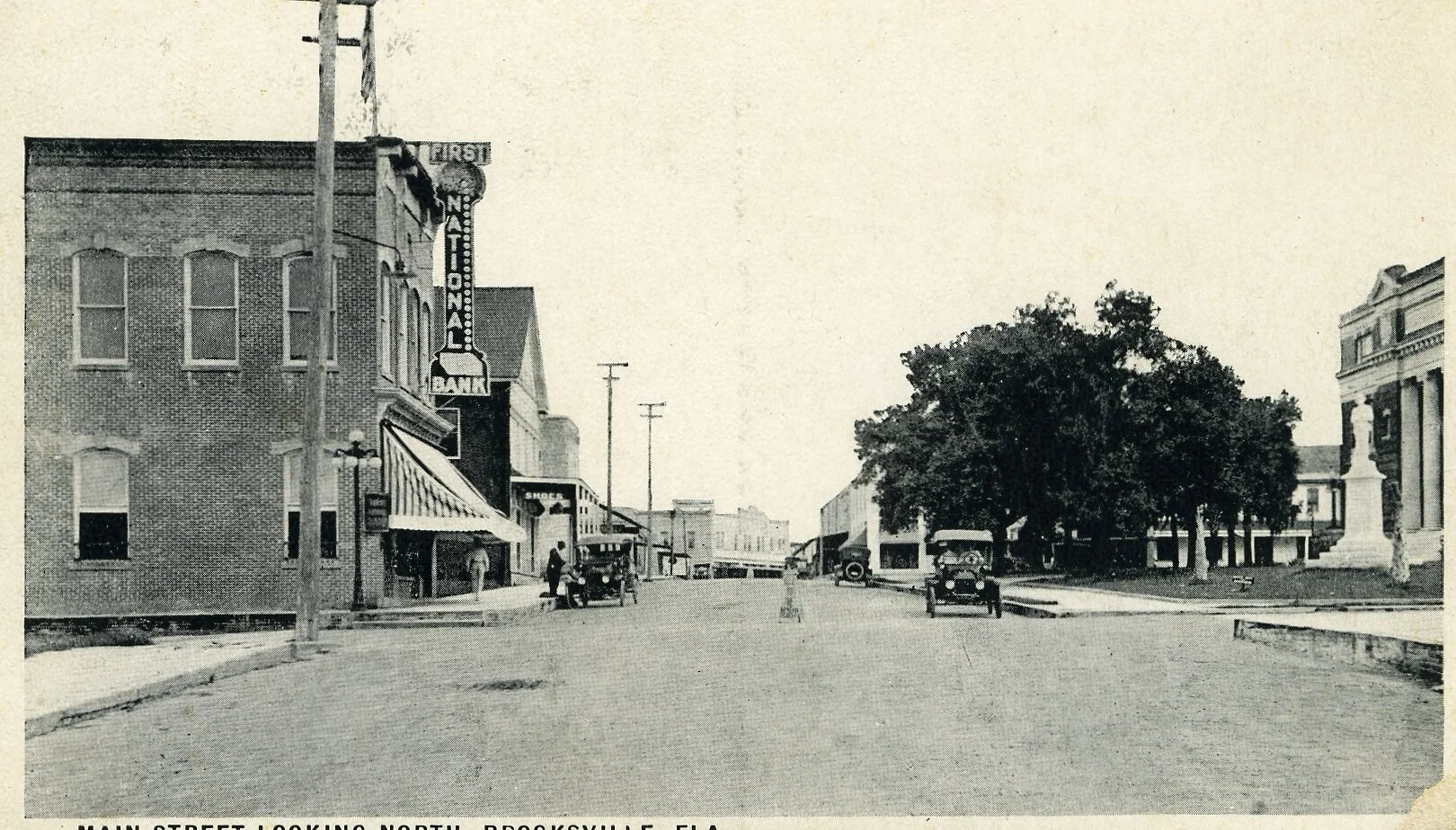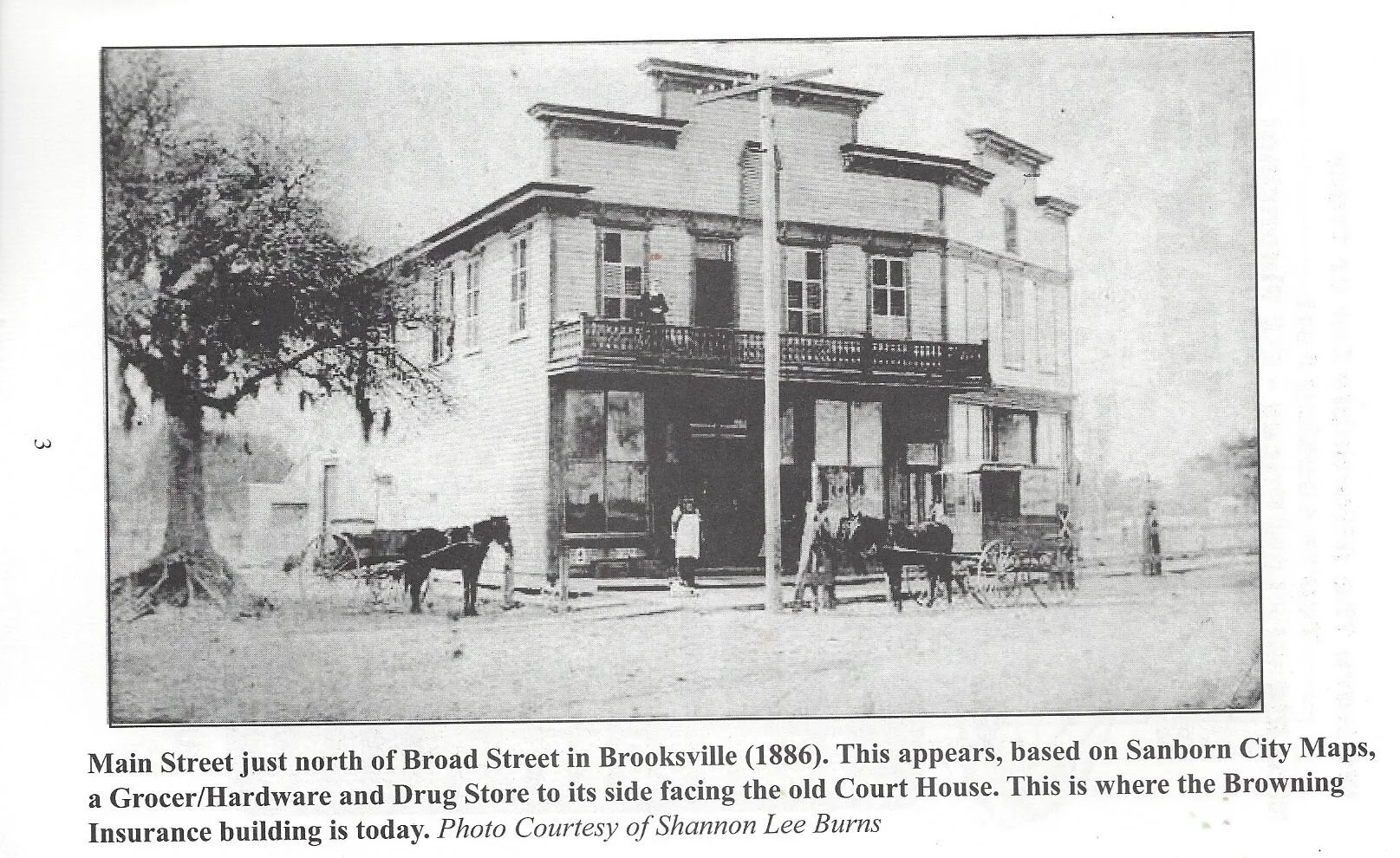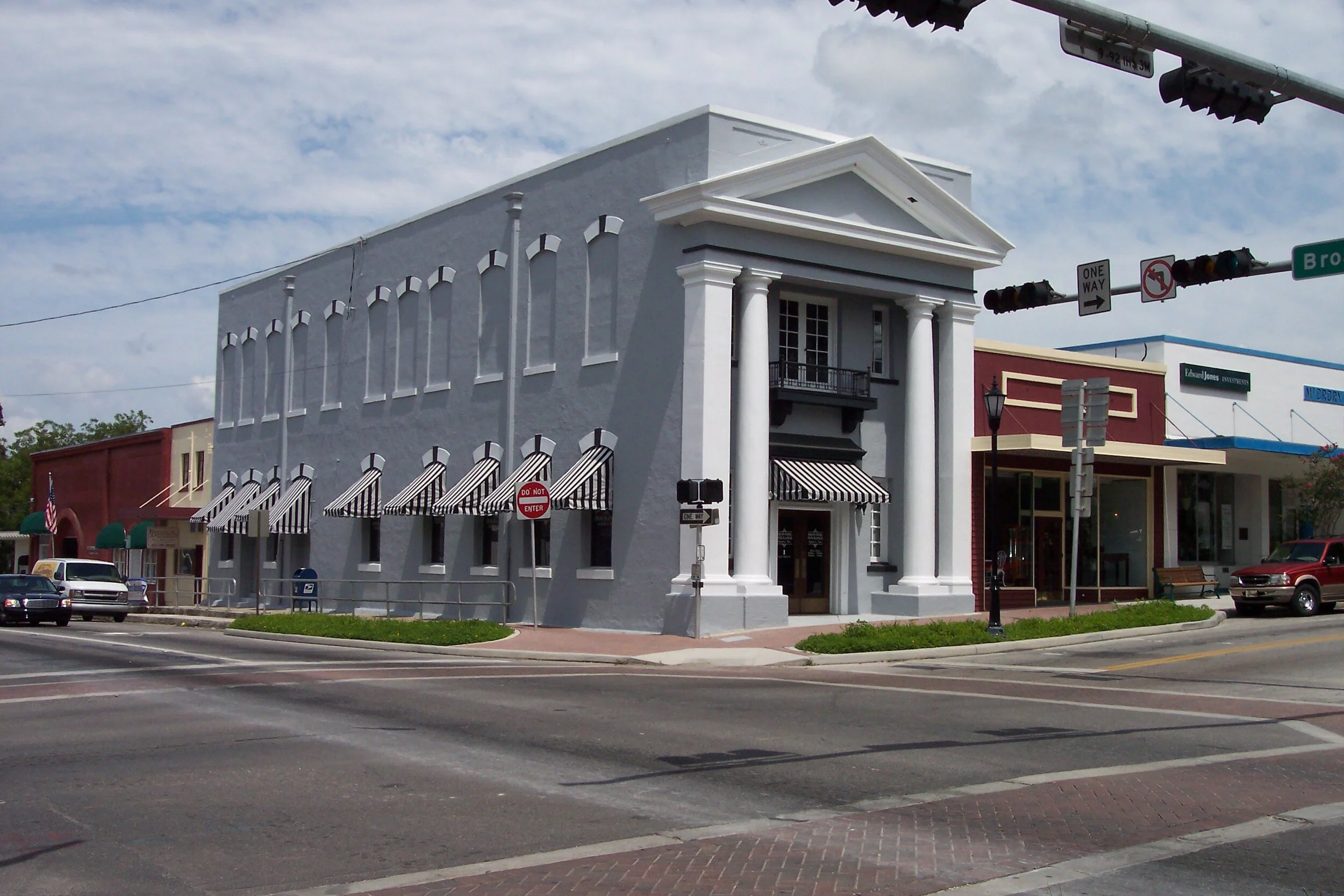
1 N Main Street
Address
1 N Main Street Brooksville, FL 34601
Year Built
1902
First Owner
Brooksville Banking Company
Pardon our dust! we are working on an all new experience for you to enjoy on TourBVL. Please scroll down for more images and information!
View North Main Street
1 N Main Street
1 N Main Street, Browning Insurance
Learn More about the Walking Tours
-
1 North Main Street – First National Bank
Step right up, folks, and gather around one of the cornerstones of Brooksville’s past—1 North Main Street, the First National Bank (originally chartered under the name Brooksville Banking Company). It’s 1908, and the air buzzes with the promise of a new century. Picture this: the clip-clop of horse hooves on the dirt road, the faint tang of turpentine drifting from nearby warehouses, and this sturdy brick building rising like a beacon of prosperity. Those cast-iron columns out front? They’re not just decoration—they’re a handshake from an era when Brooksville was flexing its muscles, ready to join the modern world.
According to Old Brooksville in Photos and Stories, the bank first opened on a rainy day in January 1908. Teller Charles Price, carrying the bank’s total assets of $15,000, slipped in the mud and sent the cash flying all over the street. Staff chased the money down and successfully launched the opening. In 1910, it was renamed the First National Bank.
Imagine walking through those heavy doors. Inside, it’s all polished wood and the sharp clink of coins. John Weeks, the bank’s first president, stands behind the counter, his mustache bristling with authority as he nods to farmers cashing in their citrus hauls and merchants borrowing for their next big venture. This isn’t just a bank—it’s the town’s heartbeat, pumping money into dreams of expansion. By 1926, the building gets a glow-up—Neoclassical flourishes etched into its facade, a nod to the grand banks of the Northeast. It’s as if Brooksville’s saying, “We’re not just a backwater anymore.”
When the Great Depression hit, Chinsegut’s owner and Bank Chairman Raymond Robins gave the bank over $200,000 to keep it solvent (equivalent to about $3.5 million today). The gift kept Brooksvillians from destitution but also meant the Robins family could no longer afford to maintain the Chinsegut estate. This ultimately led to them donating the property to the Federal government. Francis B. Coogler served as President of the bank during those difficult Depression years, but they later merged with the Hernando State Bank (see 1 East Jefferson Street for their history).
In the 1950s, the McKethan-Browning Insurance Agency moved into the building, and the Browning family purchased it in 1969. The glass doors on the front of the building are original, and the interior of the bank vault is still in place.
Now, let’s linger a moment. Close your eyes and listen—can you hear the rustle of paper as a teller scribbles in a ledger? Maybe catch a whiff of cigar smoke from a businessman sealing a deal? This place saw it all: boom times when the citrus groves bloomed, and lean years when the Great Depression hit like a freight train. The bank weathered storms—literal and financial—standing firm as a rock while the world shifted around it.
Today, the First National Bank is home to Browning Insurance, but its bones still whisper of those early days. Run your hand along the exterior, feel the texture of a century gone by, and imagine the stories locked in its vaults—tales of ambition, risk, and resilience. Before we move on, take one last look. This isn’t just a building; it’s a time capsule, holding Brooksville’s past in every crack and corner.
Citations
George Lansing Taylor Jr., "Former First National Bank, Brooksville, FL," (2010), George Lansing Taylor Collection Main Gallery, 2312, https://digitalcommons.unf.edu/historical_architecture_main/2312.
Kleine, Georg (1992) "Reform and Revolution: The Life and Times of Raymond Robbins by Neil V. Salzman," Tampa Bay History: Vol. 14: Iss. 2, Article 11.
Available at: https://digitalcommons.usf.edu/tampabayhistory/vol14/iss2/11Old Brooksville in Photos and Stories.
The Browning Family
-
1 North Main Street – Browning Insurance Building
Step right up, folks, and gather ‘round one of the cornerstones of Brooksville’s past—1 North Main Street. Today this building is referred to as the Browning Insurance Building, but it has been other things in the past. The First National Bank (originally chartered under the name Brooksville Banking Company) was the first business to reside here. It’s 1908, and the air buzzes with the promise of a new century. Picture this: the clip-clop of horse hooves on the dirt road, the faint tang of turpentine drifting from nearby warehouses, and this sturdy brick building rising like a beacon of prosperity. Those cast-iron columns out front? They’re not just decoration—they’re a handshake from an era when Brooksville was flexing its muscles, ready to join the modern world.
According to Old Brooksville in Photos and Stories, the bank first opened on a rainy day in January 1908. Teller Charles Price, carrying the bank’s total assets of $15,000, slipped in the mud and sent the cash flying all over the street. Staff chased the money down and successfully launched the opening. In 1910, it was renamed the First National Bank.
Imagine walking through those heavy doors. Inside, it’s all polished wood and the sharp clink of coins. John Weeks, the bank’s first president, stands behind the counter, his mustache bristling with authority as he nods to farmers cashing in their citrus hauls and merchants borrowing for their next big venture. This isn’t just a bank—it’s the town’s heartbeat, pumping money into dreams of expansion. By 1926, the building gets a glow-up—Neoclassical flourishes etched into its facade, a nod to the grand banks of the Northeast. It’s as if Brooksville’s saying, “We’re not just a backwater anymore.”
When the Great Depression hit, Chinsegut’s owner and Bank Chairman Raymond Robins gave the bank over $200,000 to keep it solvent (equivalent to about $3.5 million today). The gift kept Brooksvillians from destitution but also meant the Robins family could no longer afford to maintain the Chinsegut estate. This ultimately led to them donating the property to the Federal government. Francis B. Coogler served as President of the bank during those difficult Depression years, but they later merged with the Hernando State Bank (see 1 E Jefferson Street for their history).
In the 1950s, the McKethan-Browning Insurance Agency moved into the building, and the Browning family purchased it in 1969. The glass doors on the front of the building are original, and the interior of the bank vault is still in place.
Now, let’s linger a moment. Close your eyes and listen—can you hear the rustle of paper as a teller scribbles in a ledger? Maybe catch a whiff of cigar smoke from a businessman sealing a deal? This place saw it all: boom times when the citrus groves bloomed, and lean years when the Great Depression hit like a freight train. The bank weathered storms—literal and financial—standing firm as a rock while the world shifted around it.
Today, the First National Bank is home to Browning Insurance, but its bones still whisper of those early days. Run your hand along the exterior, feel the texture of a century gone by, and imagine the stories locked in its vaults—tales of ambition, risk, and resilience. Before we move on, take one last look. This isn’t just a building; it’s a time capsule, holding Brooksville’s past in every crack and corner.
Citations
George Lansing Taylor Jr., "Former First National Bank, Brooksville, FL," (2010), George Lansing Taylor Collection Main Gallery, 2312, https://digitalcommons.unf.edu/historical_architecture_main/2312.
Kleine, Georg (1992) "Reform and Revolution: The Life and Times of Raymond Robbins by Neil V. Salzman," Tampa Bay History: Vol. 14: Iss. 2, Article 11.
Available at: https://digitalcommons.usf.edu/tampabayhistory/vol14/iss2/11Old Brooksville in Photos and Stories.
The Browning Family.
-
1 North Main Street – First National Bank
Step right up, folks, and gather around one of the cornerstones of Brooksville’s past—1 North Main Street, the First National Bank (originally chartered under the name Brooksville Banking Company). It’s 1908, and the air buzzes with the promise of a new century. Picture this: the clip-clop of horse hooves on the dirt road, the faint tang of turpentine drifting from nearby warehouses, and this sturdy brick building rising like a beacon of prosperity. Those cast-iron columns out front? They’re not just decoration—they’re a handshake from an era when Brooksville was flexing its muscles, ready to join the modern world.
According to Old Brooksville in Photos and Stories, the bank first opened on a rainy day in January 1908. Teller Charles Price, carrying the bank’s total assets of $15,000, slipped in the mud and sent the cash flying all over the street. Staff chased the money down and successfully launched the opening. In 1910, it was renamed the First National Bank.
Imagine walking through those heavy doors. Inside, it’s all polished wood and the sharp clink of coins. John Weeks, the bank’s first president, stands behind the counter, his mustache bristling with authority as he nods to farmers cashing in their citrus hauls and merchants borrowing for their next big venture. This isn’t just a bank—it’s the town’s heartbeat, pumping money into dreams of expansion. By 1926, the building gets a glow-up—Neoclassical flourishes etched into its facade, a nod to the grand banks of the Northeast. It’s as if Brooksville’s saying, “We’re not just a backwater anymore.”
When the Great Depression hit, Chinsegut’s owner and Bank Chairman Raymond Robins gave the bank over $200,000 to keep it solvent (equivalent to about $3.5 million today). The gift kept Brooksvillians from destitution but also meant the Robins family could no longer afford to maintain the Chinsegut estate. This ultimately led to them donating the property to the Federal government. Francis B. Coogler served as President of the bank during those difficult Depression years, but they later merged with the Hernando State Bank (see 1 East Jefferson Street for their history).
In the 1950s, the McKethan-Browning Insurance Agency moved into the building, and the Browning family purchased it in 1969. The glass doors on the front of the building are original, and the interior of the bank vault is still in place.
Now, let’s linger a moment. Close your eyes and listen—can you hear the rustle of paper as a teller scribbles in a ledger? Maybe catch a whiff of cigar smoke from a businessman sealing a deal? This place saw it all: boom times when the citrus groves bloomed, and lean years when the Great Depression hit like a freight train. The bank weathered storms—literal and financial—standing firm as a rock while the world shifted around it.
Today, the First National Bank is home to Browning Insurance, but its bones still whisper of those early days. Run your hand along the exterior, feel the texture of a century gone by, and imagine the stories locked in its vaults—tales of ambition, risk, and resilience. Before we move on, take one last look. This isn’t just a building; it’s a time capsule, holding Brooksville’s past in every crack and corner.
Citations
George Lansing Taylor Jr., "Former First National Bank, Brooksville, FL," (2010), George Lansing Taylor Collection Main Gallery, 2312, https://digitalcommons.unf.edu/historical_architecture_main/2312.
Kleine, Georg (1992) "Reform and Revolution: The Life and Times of Raymond Robbins by Neil V. Salzman," Tampa Bay History: Vol. 14: Iss. 2, Article 11.
Available at: https://digitalcommons.usf.edu/tampabayhistory/vol14/iss2/11Old Brooksville in Photos and Stories.
The Browning Family
The Architecture
Neoclassical Revival: Flat roof, Multi-light casement and fixed windows (second floor boarded), stucco exterior.



